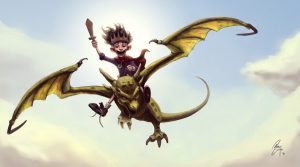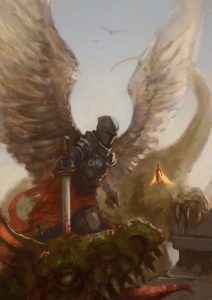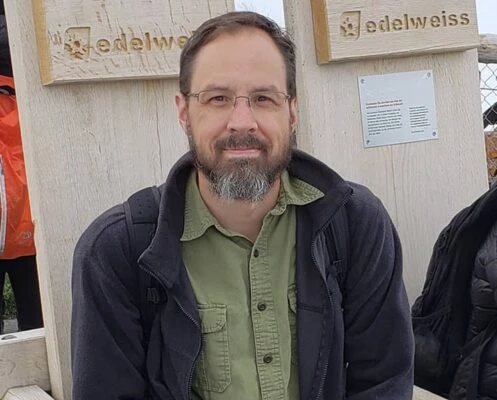
This month’s Apex Magazine cover artist is Rubén Castro, whose artworks are filled with all manner of science fiction, fantasy, and horror creatures. Varying in techniques from concept art to fully immersive fantasy scenes, Castro brings a unique vision to his art.
APEX MAGAZINE: In your piece for this month’s cover, “Alien,” the smile on the alien creature’s face could be taken as either humorous or malevolent. As an artist, how important is the interpretation of your work as you see it, versus how others might?
RUBÉN CASTRO: When I started painting the alien, I didn’t put a mouth. I think part of the horror comes with the feeling of the uncertainty or insecurity, the fear of the unknown. It makes you question this creature, how it could react if you approached, and with this in mind I thought of leaving it without a mouth. Then I started painting scars, scars that look like a smile. I like to introduce some storytelling in my illustrations, something for the viewer to start wondering what may have happened to him. Was he tortured? Did people experiment on him? If you pay attention and take a closer look at his eye, you can see, in the reflection, a silhouette of a person. I put elements in there, but I like that the viewer takes those elements and creates their own stories.
AM: Actors often talk about the challenge of doing comedy over drama, and how much more difficult the lighter side can be. With a piece like “Dragon Rider,” do you find a challenge in creating a cute vision over something like the “Alien” image? As you are working on a piece, is there a balance or a line where something moves too far away from being humorous or cute?
RC: For me, it is very challenging to create a cute piece. I find it very hard because when you make cute art, you have to think outside the box, you have to break the rules. That means playing with the proportions of human anatomy, intensifying colors, and many other things that require much more creativity than a realistic piece, in my opinion.
When I have client work, I stick with the client’s intention. If it is a serious scene, I’ll do it serious; if it is a humorous scene, I’ll do it humorous. But in my personal work, if it’s not a specific project and if I’m painting just for fun, then I’m not afraid of crossing boundaries. If a piece that started very serious turns to the humor side, I just accept it and let the painting talk and find his own voice.
AM: In the comments for your piece “Dragon Slayer,” you mentioned that it is an unfinished piece. As an artist myself, I have entire folders of unfinished work. Are there pieces that you have returned to later on, or felt the pull to rework something that you started years ago? Or do those older pieces remain in the past, part of the artist’s journey that you have moved on from?
RC: I definitely return to previous sketches or unfinished works, because in my art journey I know that I’ll never reach a certain point where I’ll consider that I got to my maximum level. That’s the beauty of art: you never finish learning new things or having new life experiences that may be included in a piece. Having this in mind, those ideas that weren’t finished at that time maybe were waiting in that folder for you to have the necessary skill to complete them, or you can take the idea and create a new one starting from them. I see art like a video game, a game that doesn’t end. You can always level up, and when you get new skills, you can go back to the areas you struggled with in the past and do it easily with the new knowledge you have.
AM: Your Tumblr has more sketches than your gallery on DeviantArt does. A number of artists treat DeviantArt as a full gallery without roughs or sketches, and in other social media they show off sketches and works in progress. Do you have a preference for your fans, or is it simply how things have worked out? Do you have a personal preference in what you like to see from other artists on their social media?
RC: I have a lot of sketchbooks and lately I’m using them as companions. If I need to type a phone number or make a list of things to do, I’ll do it in the sketchbook. I have the tendency of always dating the pages, so it’s nice to see old sketchbooks and see what was going on in my life on that particular day. I used to treat a sketchbook as a sacred thing, I was so afraid to start a new one because I thought that every page needed to have a nice drawing. But now I see them as just a place to put ideas that I may or may not turn into an illustration. A place to be free and just fill it with ideas, because maybe that awesome idea you didn’t sketch, because you wanted to draw it pretty, could get lost and fade away.
Usually I don’t like to show my sketches and unfinished works, but I think that uploading them pushes me to do more. I love DeviantArt and I think it is the place I have my best artworks, but I wanted to separate things and use my Tumblr as a digital sketchbook that I can upload silly drawings, works in progress, and other things. I also started to use Instagram for these purposes too.
I always enjoy watching other people’s sketchbooks on Conceptart.org. It’s very inspiring to see artists that you like and to look through old posts from many years ago, to see their progression to the place they are now. I also enjoy watching YouTube videos of amazing artists that show you their process. It’s very interesting seeing the decisions they use to make the illustrations. Another thing that I like is watching artists streaming on Twitch, knowing that other people are working on an illustration at that exact moment. Watching them makes you feel you’re not alone, especially if you work from home where you can spend hours isolated.
AM: Your gallery is driven strongly by magic and fantasy illustrations, with the occasional twist of horror. What does fantasy art do for you emotionally and personally as you are creating it? Do you think fans of fantasy art crave the escape from reality, or something different?
RC: I have a D&D group with my best friends. We play regularly with campaigns that can last years, and it’s been an incredible and very inspiring experience. Yes, fantasy is a way to escape reality, but also gives the opportunity to explore areas of our imagination that are endless. When you’re a kid, you have that sense of wonder, you get excited whenever you discover something new. But as you grow up, you lose that ability, you know what to expect about life and I think that is very sad.
Fantasy and horror, for me, are bringing me back to that stage of wonder. When I play D&D with my friends and have these amazing adventures, when I read a book, when I see an incredible painting or a movie, that makes me feel joy. Knowing that in fantasy there are heroes, epic battles, horrible creatures, and endless things that none have seen before waiting inside someone’s head to come out one day, for me is very exciting.
For me, fantasy has always captured my attention. Painting something that doesn’t exist is very challenging, you have to really know how reality works, how light interacts with certain materials, perspective, anatomy, color theory, etc., and then apply it to paint something that is only in your mind. While I’m painting, I try to go inside the scene, try to feel how would it be being there, how the character feels, how would it be being in that situation, how the environment affects it. Sometimes I go so deep that I lose track of time.
AM: Thank you to Rubén Castro for a great look into an artist’s mind and life. You can find more of Castro’s fantastical works on his DeviantArt page.











